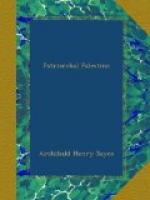The Tel el-Amarna correspondence breaks off suddenly in the midst of a falling empire, with its governors in Canaan fighting and intriguing one against the other, and appealing to the Pharaoh for help that never came. The Egyptian commissioners are vainly endeavouring to restore peace and order, like General Gordon in the Soudan, while Babylonians and Mitannians, Hittites and Beduin are assailing the distracted province. The Asiatic empire of the eighteenth dynasty, however, did not wholly perish with the death of Khu-n-Aten. A picture in the tomb of prince Hui at Thebes shows that under the reign of his successor, Tut-ankh-Amon, the Egyptian supremacy was still acknowledged in some parts of Syria. The chiefs of the Lotan or Syrians are represented in their robes of many colours, some with white and others with brown skins, and coming before the Egyptian monarch with the rich tribute of their country. Golden trays full of precious stones, vases of gold and silver, the covers of which are in the form of the heads of gazelles and other animals, golden rings richly enamelled, horses, lions, and a leopard’s skin—such are the gifts which they offer to the Pharaoh. It was the last embassy of the kind which was destined to come from Syria for many a day.
With the rise of the nineteenth dynasty and the restoration of a strong government at home, the Egyptians once more began to turn their eyes towards Palestine. Seti I. drove the Beduin before him from the frontiers of Egypt to those of “Canaan,” and established a line of fortresses and wells along “the way of the Philistines,” which ran by the shore of the Mediterranean to Gaza. The road was now open for him to the north along the sea-coast. We hear accordingly of his capture of Acre, Tyre, and Usu or Palaetyros, from whence he marched into the Lebanon and took Kumidi and Inu’am. One of his campaigns must have led him into the interior of Palestine, since in his list of conquered cities we find the names of Carmel and Beth-anoth, of Beth-el and Pahil or Pella, as well as of Qamham or Chimham (see Jer. xli. 17). Kadesh, “in the land of the Amorites,” was captured by a sudden assault, and Seti claims to have defeated or received the submission of Alasiya and Naharaim, the Hittites and the Assyrians, Cyprus and Sangar. It would seem, however, that north of Kadesh he really made his way only along the coast as far as the Gulf of Antioch and Cilicia, overrunning towns and districts of which we know little more than the names.
Seti was succeeded by his son Ramses II., the Pharaoh of the Oppression, and the builder of Pithom and Ramses. His long reign of sixty-seven years lasted from 1348 B.C. to 1281 B.C. The first twenty-one years of it were occupied in the re-conquest of Palestine, and sanguinary wars with the Hittites. But these mountaineers of the north had established themselves too firmly in the old Egyptian province of Northern Syria to be dislodged. All the Pharaoh could




